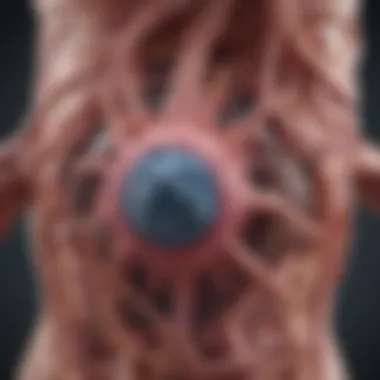Granulomatous Treatment: Insights and Strategies


Intro
Granulomatous diseases are a fascinating yet complex group of conditions that challenge our understanding of the immune system. They manifest through chronic inflammation, leading to the formation of granulomas, which are small aggregates of immune cells. These granulomas can appear in various tissues and organs, creating a wide array of clinical manifestations. Treatment of granulomatous diseases presents a unique puzzle for healthcare providers, steering them towards pharmacological interventions, lifestyle adjustments, and in some cases, cutting-edge therapies.
This article aims to shed light on the nuances of granulomatous treatment, addressing the underlying pathophysiology and the multifaceted approaches required for effective management. We will examine diagnostic tools and the importance of individualized care in addressing the needs of diverse patient populations. Furthermore, attention will also be given to the future of research and the role of clinical trials in shaping treatment standards. With this comprehensive overview, we hope to provide students, researchers, educators, and professionals with a valuable resource for navigating the complexities surrounding granulomatous treatment.
Understanding Granulomatous Diseases
Understanding granulomatous diseases is essential for anyone looking to dive into the complex world of these conditions. Granulomas, which are small clusters of immune cells, often come into play as a response to chronic inflammation or infection. Hence, grasping how and why they form is key for both diagnosis and treatment approaches. A clear understanding enables healthcare providers to better identify granulomatous diseases and tailor treatments accordingly, which can significantly improve patient outcomes. It’s like having a roadmap; without it, you may wander aimlessly when addressing these intricate health issues.
Definition and Classification
Granulomatous diseases can be defined as conditions characterized by the formation of granulomas due to a wide range of causes. These causes can include infections, autoimmune reactions, or even foreign material in the body. The classification of these diseases is broad and can be grouped generally into infectious and non-infectious types. Some well-known examples include sarcoidosis and tuberculosis, both of which carry distinctive features and management strategies.
Pathophysiology of Granuloma Formation
The pathophysiology surrounding granuloma formation involves a complex interplay between various immune cells. When the body encounters pathogens or irritants that it cannot eradicate, it opts for a more organized defense. Macrophages, T-cells, and sometimes B-cells group together, forming a granuloma as a protective enclosure. This method, while beneficial in trapping harmful agents, can sometimes lead to tissue damage and functional impairment in the affected organs. It’s a double-edged sword; while it tries to protect, it may also hurt in the long run.
Common Examples of Granulomatous Diseases
Tuberculosis
Tuberculosis (TB) is one of the best-known granulomatous diseases. The hallmark of TB is the formation of caseating granulomas that often involve the lungs but can spread to other organs. This disease poses a significant public health challenge due to its infectious nature and resistance patterns. TB stands out due to its global prevalence, making it a crucial aspect of any discussion on granulomatous diseases. Furthermore, understanding its pathophysiology helps in managing the associated complications more effectively.
Sarcoidosis
Sarcoidosis is another major player in the realm of granulomatous diseases. Often affecting the lungs and lymph nodes, it is characterized by non-caseating granulomas. A key feature of sarcoidosis is its mysterious etiology; while it affects many, the exact cause remains elusive. This makes it a compelling subject for research and clinical practice. Sarcoidosis also illustrates the diversity within granulomatous diseases, showcasing how different underlying mechanisms can lead to similar clinical outcomes.
Granulomatosis with Polyangiitis
Granulomatosis with polyangiitis, previously referred to as Wegener's granulomatosis, combines granuloma formation with a vasculitic component. This autoimmune disorder frequently affects the respiratory tract and kidneys. A unique feature of this condition is its association with specific antibodies, such as ANCA (anti-neutrophil cytoplasmic antibodies), which can be vital for diagnosis. Understanding this condition enriches our knowledge of how systemic autoimmune processes can manifest as localized granulomatous reactions.
Chronic Granulomatous Disease
Chronic Granulomatous Disease (CGD) is a genetic disorder that impairs the immune system's ability to fight certain types of bacteria and fungi, leading to recurrent infections and granuloma formations as a compensatory response. Its key characteristic lies in the inability of white blood cells to produce reactive oxygen species, which normally helps kill pathogens. CGD presents a different angle on the subject, given that it stems from inherited genetic anomalies. Thus, it raises intriguing questions about the interplay between genetics and immune response.
Grasping the nuances of these diseases aids clinicians and researchers alike in navigating the complexities of diagnosis and treatment, pushing the envelope on effective management strategies.
Diagnosis of Granulomatous Conditions
Diagnosing granulomatous conditions is crucial for effective treatment. Accurate diagnosis can mean the difference between a long road to recovery or a swift return to health. Granulomatous diseases have varied causes and presentations, making diagnosis challenging. Understanding the diagnostic process helps healthcare providers identify the disease accurately and tailor treatment strategies effectively. This section breaks down the critical elements of diagnosis, highlighting the importance of each aspect, namely clinical evaluation, imaging techniques, and histopathological analysis.
Clinical Evaluation
Patient History
Taking a detailed patient history is the backbone of the diagnostic process. It provides insight into any factors like exposure to infectious agents, travel history, or autoimmune disease family history that could contribute to granuloma formation. A key characteristic of collecting a thorough patient history is its ability to uncover patterns that may not be immediately visible during examinations or tests. This makes it a beneficial approach as it directs the healthcare provider’s intuition towards specific granulomatous diseases.
A unique aspect of patient history-taking is that it allows the healthcare provider to develop a rapport with the patient, establishing a comfortable environment for them to share vital information. However, relying solely on patient history can sometimes be misleading as patients may forget or downplay significant exposures or symptoms.
Physical Examination
The physical examination serves as the next critical diagnostic step. A careful physical exam can reveal signs such as skin lesions, lymphadenopathy, or organomegaly that might hint at a granulomatous process. The key characteristic here is its immediacy; results can be observed during the appointment without waiting for test results. This is a valuable element in the diagnostic chain, as it can guide the urgency and type of additional investigations needed.


One unique feature of physical examinations is that they can uncover subtle findings not reported in the patient’s history. For instance, a palpable lymph node can suggest sarcoidosis or tuberculosis. However, one disadvantage could be the sensitivity of the examination. Some granulomatous conditions may not present visible signs, leading to a potential false reassurance.
Imaging Techniques
Radiological Imaging
Radiological imaging, including X-rays and CT scans, plays a pivotal role in diagnosing granulomatous diseases. These imaging techniques help visualize abnormalities in organs, providing clues about the presence of granulomas. A key characteristic of radiological imaging is its non-invasive nature, making it a favored choice among both physicians and patients. Furthermore, similar presentations on imaging can be seen across different diseases, but specific patterns may help narrow down the diagnosis of conditions like sarcoidosis versus tuberculoma.
The unique advantage of this method is its ability to survey multiple organ systems concurrently. Still, one drawback is that radiological imaging can sometimes result in ambiguous findings, necessitating further investigative approaches to reach a definitive diagnosis.
Nuclear Medicine Scans
Nuclear medicine scans, such as positron emission tomography (PET), provide functional imaging, highlighting areas of increased metabolic activity that often correlate with inflammation. An essential aspect here is their ability to detect granulomatous activity even in asymptomatic patients, which can be invaluable in understanding disease progression. This makes nuclear scans a strategic choice in diagnosing granulomatous diseases, especially when there is suspicion of widespread involvement.
The unique feature of nuclear medicine scans lies in their sensitivity to active lesions compared to structural changes observed in X-rays or CT scans. However, the downside is the higher cost and potential for radiation exposure from the tracers used, highlighting the need for careful risk-benefit analysis before these invasive scans are performed.
Histopathological Analysis
Biopsy Techniques
Histopathological analysis often involves biopsy techniques to confirm the diagnosis. Obtaining tissue samples through various biopsy methods can clarify the presence of granulomas under a microscope. A critical feature of biopsy techniques is their capacity to provide definitive diagnosis, often distinguishing between reactive and infectious processes. This gives it a strong position in a comprehensive diagnostic approach.
A unique aspect of biopsy procedures is that they can be tailored based on the suspected underlying cause—whether it's through a fine-needle aspiration for lymph nodes or excisional biopsies for skin lesions. However, disadvantages include the possibility of complications and the invasiveness of the procedure, which can deter some patients.
Histological Features of Granulomas
Understanding the histological features of granulomas is key to diagnosing the specific type of granulomatous disease. Granulomas exhibit a characteristic structure, often with giant cells and a necrotic center, aiding in diagnosis. A key aspect of histological analysis is its specificity; certain patterns can strongly indicate particular diseases such as tuberculosis versus sarcoidosis. Thus, it can be considered a beneficial choice for this article.
The unique feature of histological examination lies in its detailed evaluation, which can uncover insights that imaging or clinical evaluation might miss. However, one drawback is the requirement for an experienced pathologist, as misinterpretations can lead to significant diagnostic errors.
Current Treatment Strategies
The treatment strategies for granulomatous diseases are both vital and nuanced, reflecting the diverse nature of these conditions. These strategies are customized based on the individual patient’s needs, the type of granulomatous disease, and the extent of the symptoms. In this section, we will delve into different treatment modalities, emphasizing their significance and practical applications.
Pharmacological Interventions
Corticosteroids
Corticosteroids stand out as a primary pharmacological intervention in the management of granulomatous diseases. They are anti-inflammatory medications, primarily effective in reducing swelling and suppressing the immune response. One critical aspect of corticosteroids is their immediate action in alleviating acute symptoms, such as inflammation and pain associated with conditions like sarcoidosis. They are generally considered a first-line treatment due to their broad efficacy.
- Unique Feature: Corticosteroids can be administered in various forms, including oral, intravenous, and intralesional injections, allowing for tailored approaches based on severity.
- Advantages: The swift reduction in inflammation can lead to a rapid improvement in quality of life for patients.
- Disadvantages: Long-term use can result in significant side effects, like osteoporosis, weight gain, and increased risk of infections, necessitating careful monitoring.
Immunosuppressants
Immunosuppressants play a crucial role when corticosteroids are insufficient or when patients exhibit steroid resistance. These drugs help lower the overall immune response, potentially curtailing the ongoing formation of granulomas. One key characteristic here is their long-term applicability, particularly in chronic conditions like granulomatosis with polyangiitis.
- Unique Feature: Agents such as azathioprine and methotrexate are often used in combination with corticosteroids to enhance therapeutic effects.
- Advantages: They can significantly reduce the need for higher doses of corticosteroids, thereby minimizing associated side effects.
- Disadvantages: The risk of infection is heightened due to the suppression of the immune system, which requires regular blood monitoring to manage.
Antibiotics
In certain granulomatous diseases, particularly those with a known infectious etiology, antibiotics play an essential treatment role. They are employed not only to address the underlying infectious cause but also to modulate the immune response. Rifampicin is pivotal when treating tuberculosis-related granulomas.
- Unique Feature: Antibiotics can be specific to the pathogen involved, thus ensuring targeted treatment.
- Advantages: They help in resolving the primary infection while simultaneously mitigating inflammatory reactions.
- Disadvantages: Over-reliance on antibiotics can lead to resistance, a significant concern in the context of long-term treatment.


Surgical Options
Resection of Granuloma
Surgical resection is sometimes the brightest beacon of hope for granulomatous diseases, particularly when they cause significant morbidity or when the diagnosis is uncertain. The excision of a granuloma can provide not just symptomatic relief but also an opportunity for histological examination, giving clearer insights into the condition.
- Unique Feature: This option is especially valuable when dealing with localized granulomatous lesions that obstruct vital structures, such as airways or blood vessels.
- Advantages: Provides immediate relief from symptoms and facilitates definitive diagnosis.
- Disadvantages: Surgical risks, including infection and complications from anesthesia, must always be weighed.
Drainage Procedures
In situations where granulomas lead to the formation of abscesses, drainage procedures become necessary to reduce pressure and prevent further complications. This method offers a less invasive option that can effectively alleviate symptoms.
- Unique Feature: The drainage can often be done percutaneously, using ultrasound guidance to avoid larger surgical interventions.
- Advantages: Quick recovery times and the ability to manage symptoms while preserving healthy surrounding tissue.
- Disadvantages: If not adequately managed, there is the possibility of recurrence or incomplete drainage, prolonging the patient's challenge.
Emerging Therapeutic Approaches
Biologics
Biologics are gaining ground as promising treatment options, particularly in difficult-to-treat granulomatous conditions, such as refractory sarcoidosis. These agents target specific components of the immune response. They often prevent or reverse granuloma formation by acting on pathways that lead to inflammation.
- Unique Feature: Their specificity ensures limited side effects as they do not broadly suppress the immune system.
- Advantages: Biologics can bring patients relief when conventional therapies fail. They offer a new horizon for patients who previously faced limited options.
- Disadvantages: The high cost and potential for allergic reactions or infections can be hurdles to widespread use.
Gene Therapy
Gene therapy is an exciting frontier in the treatment landscape for granulomatous diseases, aiming at correcting underlying genetic abnormalities that may predispose an individual to these disorders. While still mostly in the research phase, its potential to address granuloma formation at the source is groundbreaking.
- Unique Feature: It can be tailored to target specific genetic mutations correlated with disease susceptibility.
- Advantages: The possibility of a long-lasting cure rather than mere symptom management is a significant draw.
- Disadvantages: Ethical concerns and high costs, along with uncertainty about long-term efficacy, impose challenges on its implementation.
Patient Management Considerations
The management of granulomatous diseases hinges on understanding the unique challenges presented by each patient's condition. Each individual brings their own medical history, genetic background, and psychosocial factors into the mix, making the role of tailored patient management crucial. Focusing on patient management means delivering care that is not just effective but also personalized to meet the specific needs of the individual. In this section, we’ll dive into several key areas including individualized treatment plans, the importance of ongoing monitoring and follow-up, and the necessity of addressing any comorbidities.
Individualized Treatment Plans
Each patient diagnosed with a granulomatous disease has distinctive health requirements. Individualized treatment plans play a pivotal role in addressing those requirements. These plans take into account various factors such as the specific type of granulomatous condition, its severity, the patient’s age, and overall health conditions. According to recent studies, personalization increases treatment efficacy and enhances patient satisfaction.
For example, a treatment plan might focus on environmental factors for a patient with sarcoidosis because exposure to certain allergens can exacerbate their symptoms. Such planning often involves multidisciplinary teams working closely with the patient to craft a strategy that truly fits their profile. The flexibility inherent in these plans allows adjustments based on the evolving landscape of a patient’s health, making it an effective choice for managing granulomatous diseases.
Monitoring and Follow-up
Regular monitoring and follow-up are integral components of effective patient management. These processes ensure that treatment plans remain relevant and effective. They help healthcare providers track progression or regression in the patient’s condition and adjust the care regimen as needed.
Clinical Assessments
Clinical assessments can be considered the backbone of effective longitudinal care. These evaluations involve a combination of patient interviews and physical examinations, allowing for real-time feedback on treatment effectiveness. One of the key characteristics of clinical assessments is their ability to provide immediate insight into symptom fluctuations, which is crucial for conditions that can vary widely from one day to another.
A significant advantage of regular assessments is the early detection of potential complications. This proactive approach can forestall more serious health issues from developing. However, they do have limitations, particularly concerning subjective biases in patient reporting.
Laboratory Evaluations
Laboratory evaluations complement clinical assessments by providing quantitative data that can encapsulate the underlying biological factors at play. Blood tests, imaging studies, or tissue biopsies can reveal insights into inflammation levels, infection status, or even genetic predispositions. A prominent characteristic of laboratory evaluations is their objectivity; unlike clinical assessments, they rely on hard data rather than self-reporting.
Despite their benefits, these evaluations aren't without downsides. They often entail waiting for results which can delay treatment modifications. Additionally, not every test is practical or accessible for all patient demographics, thus limiting their application. Still, integrating laboratory evaluations into patient management ensures a data-driven approach to treatment.


Addressing Comorbidities
Comorbid conditions can significantly impact patient outcomes in granulomatous diseases. These are common alongside granulomatous diagnoses, such as diabetes or hypertension, and their presence can complicate treatment plans. Therefore, addressing comorbidities is essential in ensuring comprehensive care.
Multidisciplinary approaches that involve specialists can bring valuable knowledge into the mix. Coordination between various healthcare providers can lead to a holistic treatment plan that does not just focus on one ailment but acknowledges the interconnectedness of multiple health issues. Effective management of comorbidities not only improves quality of life for the patient but also enhances the effectiveness of the treatment plan overall.
Research and Future Directions
The exploration of research and future directions in granulomatous treatment is vital to understanding how we can better manage these complex conditions. Research in this area not only opens up new avenues for therapies but also deepens our comprehension of the underlying mechanisms that drive granuloma formation. As clinicians and scientists probe deeper into the pathophysiology, they unravel the intricacies of immune response and disease manifestation.
One of the notable benefits of advancing research is the potential for more personalized approaches in treatment. The variability of granulomatous conditions means that a one-size-fits-all treatment may not always suffice. Therefore, elucidating the specific mechanisms at play in individual cases has become paramount. As we follow the threads of ongoing inquiries, the hope is to yield better diagnostic tools, refined therapeutic strategies, and ultimately improved patient outcomes.
Furthermore, the consideration of emerging technologies, such as genomic screening and advanced imaging techniques, offers promising insights into individualized treatment plans. This area of research holds the promise to shift paradigms and reframe the way we view granulomatous diseases. Continual advancements in biotechnology create exciting opportunities to innovate therapeutic responses that target the root cause of disease, rather than merely managing symptoms.
Current Clinical Trials
Current clinical trials serve as a cornerstone for progress in treating granulomatous diseases. These trials not only evaluate the safety and efficacy of new treatment options but also provide invaluable data on disease progression and response to therapies. As new compounds and biologics emerge, trialing them in controlled environments allows researchers to fine-tune their approaches.
- Types of trials
- Randomized controlled trials
- Open-label trials
- Phase I to Phase III studies
The focus of these trials can range from evaluating new medications to exploring advanced techniques in patient management. Many are directed at specific conditions like sarcoidosis and granulomatosis with polyangiitis. Participation in these trials often provides patients access to cutting-edge treatments that are not yet widely available.
Concepts in Granuloma Pathogenesis
Understanding the concepts in granuloma pathogenesis is crucial for both researchers and healthcare professionals. It involves unraveling the mechanisms that culminate in the formation of granulomas—a specialized collection of immune cells that represents a chronic inflammatory response. For instance, the role of T-helper cells in modulating immune responses is central to how these lesions develop and persist.
Scientific inquiry into the cellular and molecular triggers behind granuloma formation reveals nuances that can lead to targeted therapies. Disrupting pathways involved in cellular signaling could diminish the formation or perpetuation of granulomatous tissue.
"Through understanding the pathogenesis of granuloma, we unlock pathways to more effective and specific treatment modalities."
Potential for Novel Therapies
The potential for novel therapies in granulomatous treatment is an exciting frontier in medical research. With the advent of biologics and targeted therapies, practitioners are no longer limited to older classes of medications. Innovations in therapeutic strategies could replace or complement conventional treatments, providing more effective means of managing symptoms and reducing inflammation.
Here are some promising areas:
- Biologics: Targeting specific pathways involved in inflammation and immune response.
- Immunotherapy: Harnessing the body’s immune system to either boost response against aberrant granuloma formation or to suppress immune dysregulation.
- Gene Editing: Utilizing tools such as CRISPR technology to modify the behavior of cells responsible for granuloma formation.
As researchers delve deeper into these potential therapies, the landscape of granulomatous treatment is bound to evolve, providing hope for more effective management options for patients.
Closure
In the realm of healthcare, understanding the complexities of granulomatous diseases is not just important, it is essential. This article highlights the multifaceted nature of these conditions, from their underlying pathophysiology to the various treatment modalities available. Having a comprehensive grasp of granulomatous treatment allows healthcare providers, educators, and researchers to make informed decisions, ultimately enhancing patient care.
Summary of Key Insights
- Granulomatous diseases are characterized by the formation of granulomas, which can arise from diverse etiologies, including infections, autoimmune disorders, and environmental factors.
- Diagnosis involves a synergy of clinical evaluation, imaging techniques, and histopathological analysis, ensuring accurate identification of these complex conditions.
- Current treatment strategies span pharmacological interventions, such as corticosteroids and antibiotics, to more innovative approaches like biologics and gene therapy. Each treatment must be tailored to the individual patient's needs, reflecting the importance of personalized medicine.
Ultimately, a thorough understanding of the available treatment options equips providers with the tools to optimize patient outcomes.
The Importance of Continued Research
The ever-evolving landscape of granulomatous treatment necessitates ongoing research. As we uncover more about the mechanisms behind granuloma formation and the varied responses to treatments, we advance our ability to tackle these conditions effectively.
- Clinical trials play a pivotal role in this journey. They not only support the validation of existing therapies but also explore new, uncharted territories in treatment.
- Ongoing investigations into granulomatous diseases can lead to novel therapeutic options that could significantly improve prognosis and quality of life for patients.
Therefore, fostering a culture of research, collaboration, and continuous learning is critical. It empowers the medical community to stay ahead of the curve and effectively address the challenges presented by granulomatous diseases.







